Growing Blog
Growing Shiitake Mushrooms
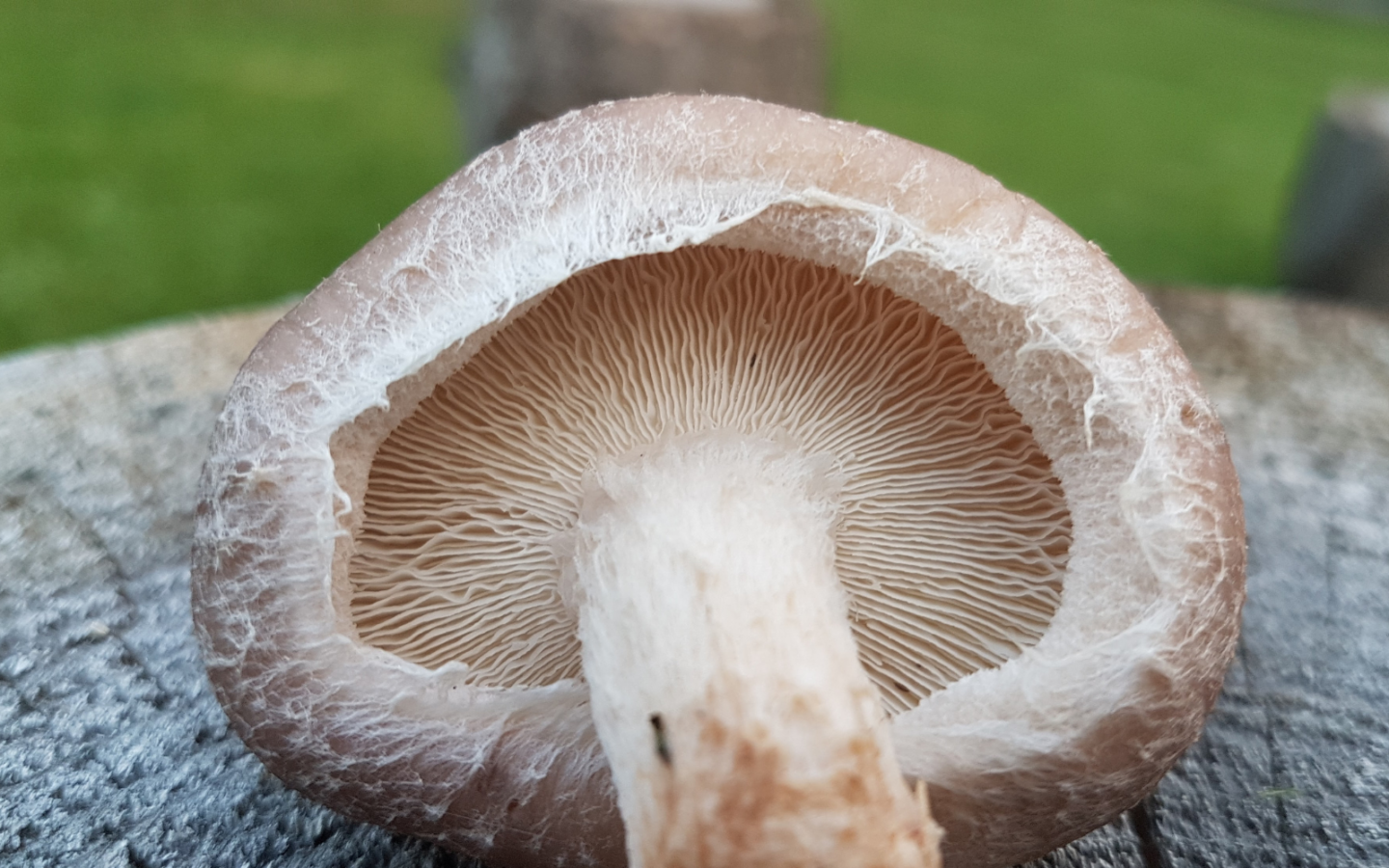
There are few mushrooms as iconic as The Shiitake.
And although growing shiitake mushrooms requires some specialized skills and tactics, it is still a strong favorite among cultivators- both professional and amateur alike. In fact, Shiitake is one of the most commonly cultivated mushrooms in the world. And for good reason. The Shiitake is a culinary delight, has a long shelf life, and when grown right, can produce bountiful yields.
There are a few different ways to grow shiitake.
Traditionally, Shiitake mushrooms were grown on hardwood logs and stumps, with pioneering methods developed in Japan many decades ago. The “soak and strike” method consisted of soaking inoculated hardwood logs followed by striking them with a hammer- causing the logs to fruit.
This method of growing shiitake outdoors on logs is still quite popular today, but most commercial and hobby cultivation is now done using hardwood sawdust fruiting blocks – allowing for more predictable and more profitable cultivation.
I just finished up with a successful Shiitake grow at home, and wanted to share the results with you- so that maybe you can try growing this mushroom as well.
But before we get into that, let’s see what this mushroom is all about!
The Shiitake Mushroom
Scientific Name: Lentinula edodes
General Description
Shiitake mushrooms will start to pin from large knots formed on the surface of the substrate, eventually developing into a more traditionally shaped cap and stem mushroom. The cap is dark to light brown and speckled with a rough white tissue, remnants of an earlier stage of growth. The stem is also quite rough, with a fibrous texture – appearing as if it was scraped with a fork. The cap size can vary greatly, from 1-5 inches, depending on the strain, growing conditions and time of harvest. The gills of the shiitake mushroom are serrated, and white in color.
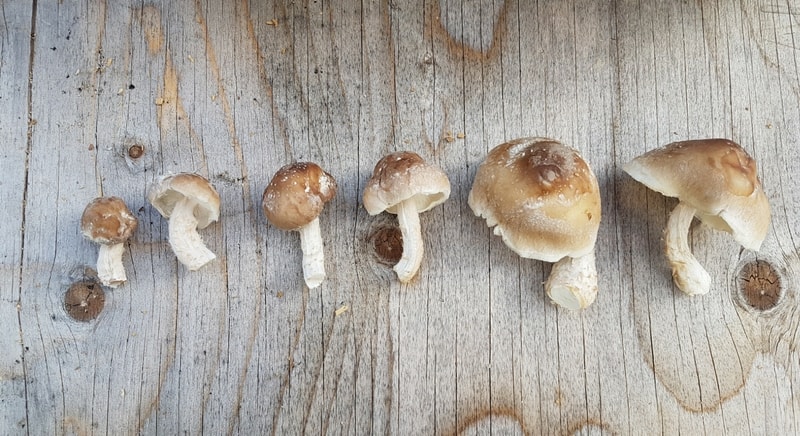
Natural Habitat: Usually found on dead hardwood logs and stumps, most commonly shii, oak, maple and beech. Also found on poplar. Shiitake is sometimes found on living trees, but will only feed on dead tissue.
Difficulty of Cultivation: Medium to Difficult.
Agar: Shiitake mycelium grows quite vigorously on agar. It will often start off quite thin and whispy, rapidly becoming thicker, and eventually turning brown with age. This browning is not contamination, but rather a natural stage of growth. MEA works well for Shiitake.
Spawn Types: Shiitake grows well on both sawdust and grain. Grain is recommended for at least the first generation. Suitable grains are rye, sorghum, millet, or a combination of these.
Substrate Types: Shiitake grows on hardwood. Hardwood sawdust blocks work best. Low levels of supplementation with oat bran or wheat bran improves fruiting, but some say too much supplementation can cause odd looking fruits and lower yields. Some strains have also been developed which will grow on straw.
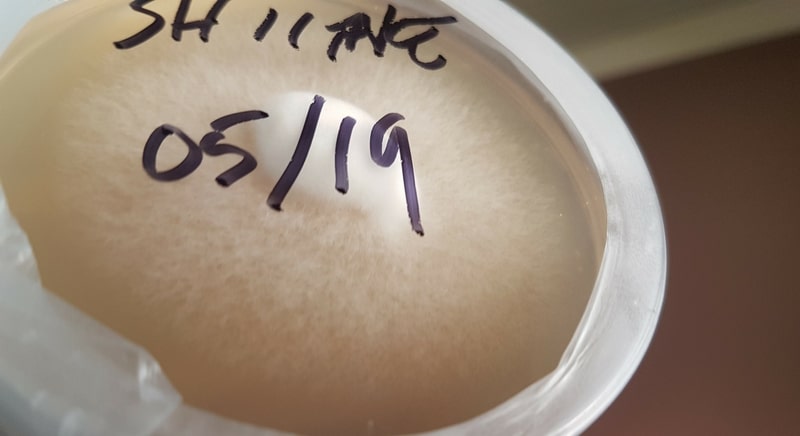
Shiitake Myceluium on Agar. This mycelium is still young, and has not yet browned.
Fruiting Containers: For indoor cultivation, use large autoclavable grow bags. Once the block has fully colonized, leave the block in the bag until it forms large knots and a brown outer crust. Cold shock, and remove from the bag entirely before fruiting. Can also be grown on hardwood logs for outdoor cultivation.
Yield: Anywhere from 1.5 to 3 lbs can be harvested from each 5 lb fruiting block over a number of flushes. Expect to yield anywhere from 0.75 – 1.0 lbs on the first flush. It is common to completely dry out the fruiting blocks for a 1-2 week resting period between flushes.
Harvest: Shiitake mushrooms can be harvested at range of different sizes. Many cultivators prefer to harvest the mushrooms when young. Allowing the mushrooms to grow larger, up to the point where the cap flattens, will increase the yields- although the quality of the fruit begins to diminish. You should definitely harvest shiitake before the spores are dropped.
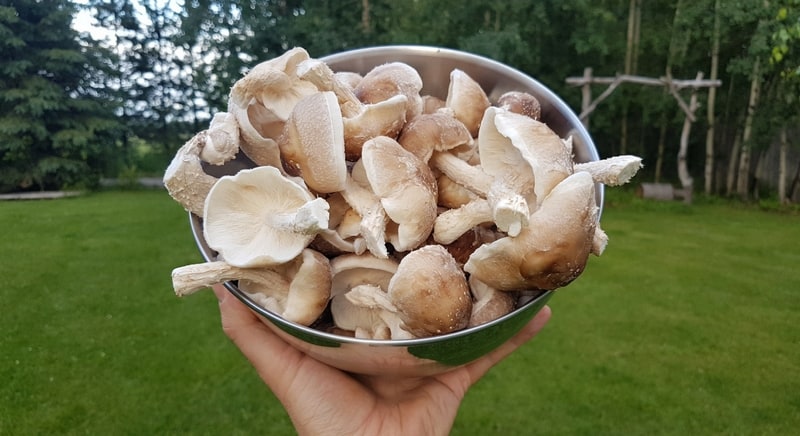
Weakness: Shiitake fruiting blocks typically take much longer than oyster mushrooms in order to get to the fruiting stage from the time of inoculation. They also prefer a cold shock in order to initiate pinning. Shiitake requires a longer “resting period” between flushes, where the blocks are to be dried out before being re-soaked for a second flush.
Cooking: Shiitake mushrooms are certainly a favorite in the kitchen. Add to a whole variety of dishes, from soups to pastas and everything in between. Requires slightly longer cooking times than oyster species or typical button mushrooms.
The Specifics
Spawn Run:
Incubate grain spawn at room temperature or slightly above for about 3 weeks. Spawn should be shaken a couple times to increase the speed of colonization.
Initiate Pinning:
Cold shock the fruiting blocks at 3-5 deg C for 12-24 hours. Allow pins to form inside the bag, then remove the entire bag from the fruiting block and keep at 95-100% RH for 3-4 days.
Fruit Development:
Aim for 18 deg C for best results. Humidity should be around 80%. Shiitake will form normal looking fruits at elevated CO2 levels, making fresh air less of a concern than for oyster species.
A Recent Shiitake Grow
On May 5th I inoculated 4 supplemented sawdust fruiting blocks with about 2.5 lbs Shiitake Mushroom grain spawn. The blocks were allowed to colonize for about 7 weeks, and then put in the fruiting chamber. I ended up harvesting about 4 lbs from the 4 blocks on the first flush, and they are currently drying out for a resting period before the second flush.

Substrates for Growing Shiitake
When it comes to suitable substrates, Shiitake is a little pickier than the easy-going oyster mushroom. Most strains will only grow well on hardwood, and even adding supplementation is a point of contention with some growers- who claim that high levels of supplementation will cause mutated fruits. I have tried this, and although I likely don’t have enough data for a true test, I find that supplementation with oat or bran flour still produces excellent results.
In fact, for these blocks, I used the same recipe as I use for most other gourmet mushrooms I grown – hardwood fuel pellets, wheat bran and water. The bran is added at 1.25 cups per 5 lb fruiting block.
Inoculation
These blocks were inoculated at a pretty high spawn rate, namely 2.5 lbs of spawn, evenly distributed between the 4 blocks, which equates to about 12.5% or about 0.625 lbs of spawn per bag.
A high spawn rate like this not only increases the speed of colonization, but also acts to further “supplement” the blocks, since the grain is highly nutritious and can help to improve time-to-fruit and overall yield. This level of spawn rate is not always economical on a commercial scale, but for home growers, it can increase the chances of success.
The grain spawn used was FreshCap Shiitake Spawn, which utilozes a high yielding and aggressive strain grown out on sorghum grain. This particular strain grows exceptionally well on hardwood- which is an important distinction, because there are strains that have been developed that will grow well on straw.
Check out this video below for how I inoculated these blocks.
After inoculation, the blocks were set on a shelf in room temperature and normal lighting conditions, and left relatively undisturbed- other than periodic checking to monitor the progress of the colonization.
Colonization of Shiitake Blocks
At first, Shiitake blocks look much like any other mushroom as the mycelium works its way through the block. The mycelium tends to be thin in some places, and thicker in others. Once the block is fully colonized, it will enter a consolidation period that is different from most other mushrooms.
Many other types of gourmet mushrooms, Oysters and Reishi in particular, will begin to pin immediately after colonization, sometimes even before. The pins will usually form on the top of the block, signalling that it is time to fruit the mushrooms.
Shiitake, on the other hand, will continue to “consolidate”, strengthening the mycelium and forming large bulbous knots of mycelium all over the outside of the block. This is sometimes referred to as “popcorning.” These blobs will eventually lead to pins.
The block will also start to change color, with large portions of the block (sometimes the whole thing) starting to turn brown. Many first time growers will take this as a sign of contamination- but it is in fact exactly what you want to see.
These particular blocks were allowed to colonize for about 7 weeks, substantially longer than most other species. I could have even let them consolidate for longer, but I was eager to get them into the fruiting chamber! By the time the consolidation period was over, the blocks were completely covered in hard bulbous knots, but were not yet starting to brown all that much – although some brown was definitely showing on some parts of the block.

Smacking Shiitake
A seemingly odd, but proven technique for fruiting shiitake involves giving the blocks a good smack. This technique has been used for many years, initially done by striking large shiitake logs with a hammer. The thought is that the “smack” simulates the colonized tree falling over in the forest; which is a natural pinning trigger.
You don’t have to smack your blocks all the hard. Just a simple slap on all sides of the block is usually sufficient. I gave these blocks a good hearty smack right before moving them into the cold shock.
Cold Shocking Shiitake
In order to initiate pinning, shitake mushrooms should also be cold shocked before being placed into fruiting conditions. This tells the mushrooms that winter is coming… and it’s now or never if they want to reproduce. This involves reducing the temperature of the block to around 4-5 deg C for a period of 12-24 hours.
The simplest way to do this is to place your fruiting blocks in the fridge. I shoved these blocks into the fridge, and left them for about 16 hours- but they definitely took up a lot of room! I know that not everybody has a dedicated fridge they can use for cold-shocking shiitake, so you may need to get creative. Try placing them outside overnight if the temperatures in your area get at least below 10 deg C overnight. You could also try using a cooler with ice. Even just placing them in a colderr area in your house, such as a garage floor or cold room may have a positive effect on fruiting.
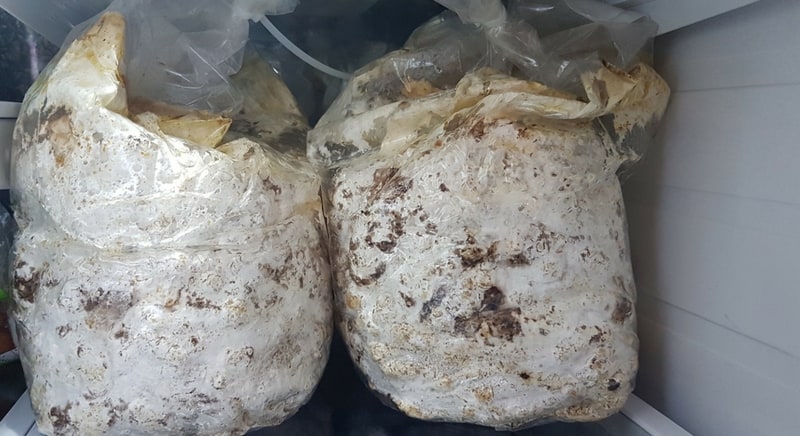
Fruiting Shiitake
Another unique aspect of growing shiitake is the method of completely removing the blocks from the grow bag before placing in the fruiting chamber. A more typical method –used for oyster, Reishi, lions mane ect – is to either cut small slits in the bag or remove just the top. With Shiitake however, all six sides of the block should be completely exposed to the environment.
That being said, it is advisable to let them rest in the bag after the cold shock for a day or so before removing the bag. This allows for an easier transition to fruiting conditions, while the high humidity inside the bag helps to initiate the original pins.
For this grow, after taking these fruiting blocks out of the fridge, I simply set them in the fruiting chamber for a day before taking them out of the bag.
Once they had returned to room temperature, I removed the bags completely and set them on the wire racks inside the chamber.
Temperature and Humidity
Shiitake is much less sensitive to fluctuations in temperature and humidity than other mushrooms.
Although a higher humidity is definitely preferred, especially for the early pinning stages, allowing the humidity to dip below 65% once in a while as the mushrooms are growing in size doesn’t seem to negatively affect the results at all. In fact, fluctuating the humidity in this way actually helps by reducing the possibility of contamination – specifically with multiple flushes.
Temperature preferences are definitely strain dependent. Shiitake usually prefers colder temperatures, but warm weather strains have been developed which allows for good results in warmer climates. The temperature can affect the size and quality of the fruits. Keeping temperatures around 18 deg C is usually a good bet – producing thick healthy fruits.
For these blocks, I set them in a fruiting chamber that was hooked up to a humidifier and fan set on a timer. This brought in fresh humid air, scheduled to only go off for 1 minute every hour. This level of fresh air produces odd looking fruits for oysters, but the Shiitake weren’t at all bothered by the relatively high levels of CO2. Temperatures were consistently under 20 deg C for the duration of the grow.
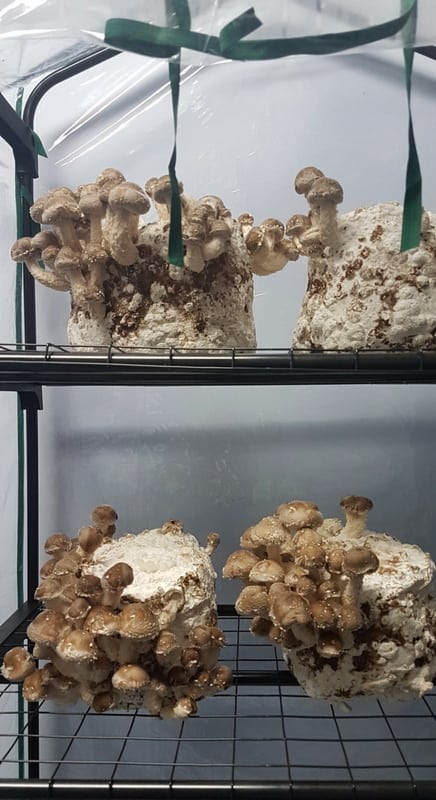
Fruitbody Development
Real pins started to form after about 3-4 days in the fruiting chamber. They are first notices as cracks in the brown blobs of mycelium. Once the pins arrive, growth is rapid, with full sized fruits developing in about a week. Large difference in the size of the fruits is easily noticeable overnight.
I left the timer at the same schedule for the duration of the fruiting process. Best practice would recommend higher humidity at the early stages of growth, while reducing humidity substantially as the fruits get closer to harvest. Leaving the same humidity and fresh air schedule however seemed like the most practical approach, and ended up producing some really nice results.


Harvest
When to harvest shiitake is a matter of personal preference. Small fruits are usually more desirable in the kitchen, as they are more flavorful and have a better texture than older fruits. Younger fruits also have a longer shelf life. Because of this, commercial growers usually harvest the fruits right before the caps start to uncurl from the stem.
Allowing the fruits to grow larger will increase the overall yield substantially, but the reduction of quality in the fruits usually negates the advantage of higher yield. Larger fruits have thinner flesh in the cap, and are more sensitive to damage from handling. They also won’t last as long in the fridge. Eventually the caps will flatten out completely, and drop spores, at which point the shiitake is definitely past its prime.
These particular blocks were harvested on June 28, about 8 weeks after initial inoculation. This is relatively fast; even though I did let the shiitakes grow just a little longer than I should have. Personally, I am a little more interested in growing them than eating them- so I like to let them grow to the point right before they start to flatten out. Of course, not every fruit is going to be at the same stage of growth- so any harvest is going to have a wide range of fruit varieties.
The blocks produced about 4 lbs from the four blocks, which is a really good yield for the first flush, even though some of the fruits were slightly overgrown.
To harvest shiitake, take a sharp knife and cut the mushroom off at the stem, allowing it to fall into a basket, bowl, or other suitable container. Although shiitake mushrooms are pretty resistant to damage, it is still best to minimize the amount of handling.
Shiitake can be stored for much longer than many other types of mushrooms. Try to harvest them when the outside of the mushrooms are relatively dry, and allow the surface to dry almost completely before placing in the fridge. If harvested in this way, shiitakes can be kept in the fridge for up to 2 weeks.
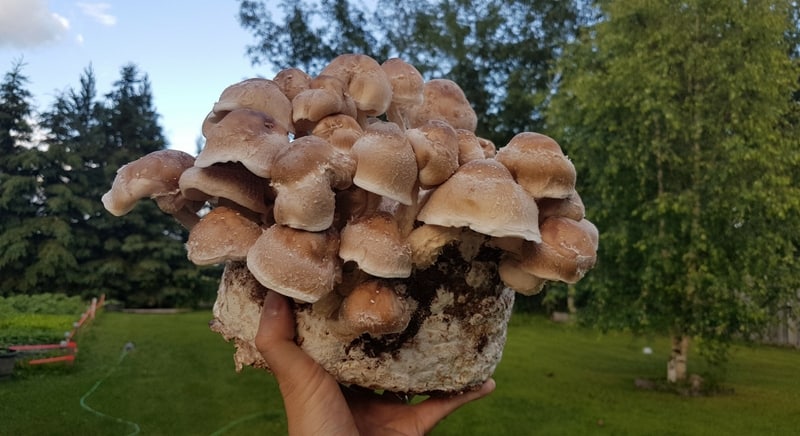
Multiple Flushes
Shiitake fruiting blocks can produce multiple flushes, with the second and third flush sometimes producing even better results than the first. That being said, they require a “resting period” where the cultivator allows the blocks to dry out and re-energize for a second flush. After at least 1 week of drying out, the blocks can be re-hydrated by soaking in a tub of water for 24 hours or so before being introduced into fruiting conditions once again.
After harvesting these blocks, I simply set them up on a shelf to dry at normal room conditions. You may have to rotate the blocks a couple times over the first day or so in order to prevent green molds forming on the outside of the block- but once they are dry, they extremely resistant to contamination.
I plan on re-hydrating these blocks, and maybe putting them outside for a second flush- but that will be the topic of another post!
Try Growing Shiitake
Although growing shiitake is a little more involved than many other species, it is not as bad as you may think. Once you understand the intricacies of this mushroom, it might just become your favorite species to grow.
If you are interested in growing Shiitake, this exact strain is available here in 2.5 lb and 10 lb bags.
Let me know if you have any questions about this grow, or growing shiitake in general.
Happy growing!
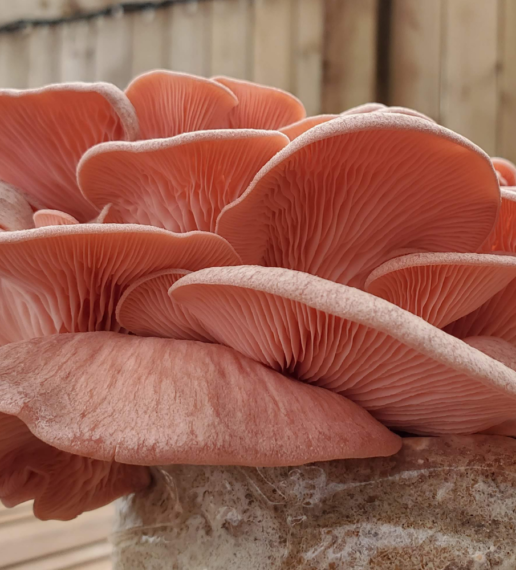
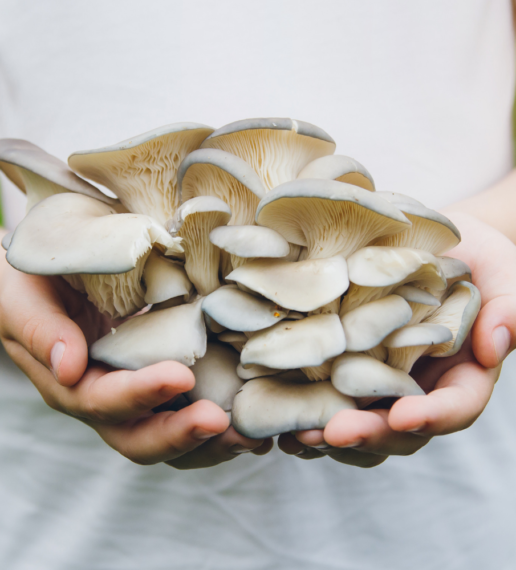
I am interested in growing Shiitake mushrooms as a business since I recently retired and want to learn more. I reside in Hawaii. What is the best and easiest way to learn? Do you allow visitation or working for a short period (such as a week or less) so one can learn?
I also want to automate the process as much as possible.
Hey there! Thanks for reaching out! I would start with a kit to get a hang of the process, from there, maybe try growing from spawn and pick up a few techniques. You can check out this page for a idea of where to start: https://learn.freshcap.com/start-here/ I currently am not able to offer any kind of internship or training, but it is something I am considering in the future!
You said there are some strains that grow on straw. What are they and do you carry them, or know someone else who does, if you don’t? Thanks!
Hey love the write up it is doable i am going to give it a trial
Hello, I am interested in learning to growing shiitake in blocks. I have been doing logs but want to expand. I have been growing the shrooms for 3yrs.
Well done. Perfect write up to anyone thinks or just starting to grow.
Hey Robert! Thanks for checking it out, I am glad you stopped by 🙂
Hey man! 🙂 great article! Do you think that there is a chance to initiate second flush by just misting the blocks a bit heavier then usually? (I´m just thinking of a larger fruiting room where you´d need to move all the blocks away, let them rest and soak and then take them back in the grow room again). Is T.R. Davis doing a second flush?
Hey! Glad you like it! I am not sure what T.R. davis is doing right now, but ya, you could certainly try to just mist and wait for the second flush without a rest… give it shot!
I really love your write-up
& will like to give it a trail thanks.
hi there, and thanks so much for sharing your information. I am about to start growing shiitakes, and am wondering about watering. how much water do you put into your initial fruiting bag? do you water the blocks at all during colonization? is the humidity added to the fruiting room the only moisture you give them?
thanks!
Awesome post! I’ve just started fruiting my first try of shiitake! Great info 🙂
Hello Tony, thanks for the nice work you do. Really appreciated. So I am using a martha fruting chamber for growing oysters and shitake mainly. For humidity I use a 3 disk mist maker and a small fan, all connected to a humidity controller. I have a 4inch 63CFM fan exhaust that runs for 1 minute every 4 minutes. I have also made some cuts and slits to the tent and usualy keep the door half unzipped. I manage to get some good fruits but also in most cases I get leggy bodies. In your text you mention that you keep the humidifier and fan running all time (stopping 1 minute per hour). Dont you get a lot of condensation? What is the humidity you aim? Any advice on my setup that I could get more FAE but keeping it moist? Thanks
I have a question on cultivating shiitake. I have done my homework for the most part I have the grain(rye) just needs to be prepped and I am getting the supplies to make the sub(hard wood pellets and oat/wheat bran). I have mycelium growing on agar, form a clone sample I took. It is grown over most of the dish in only 8 days I was supersized as this was my first time cloning. My question is when should I put it to grain, when its still young or when it starts to age and starts turning brown?